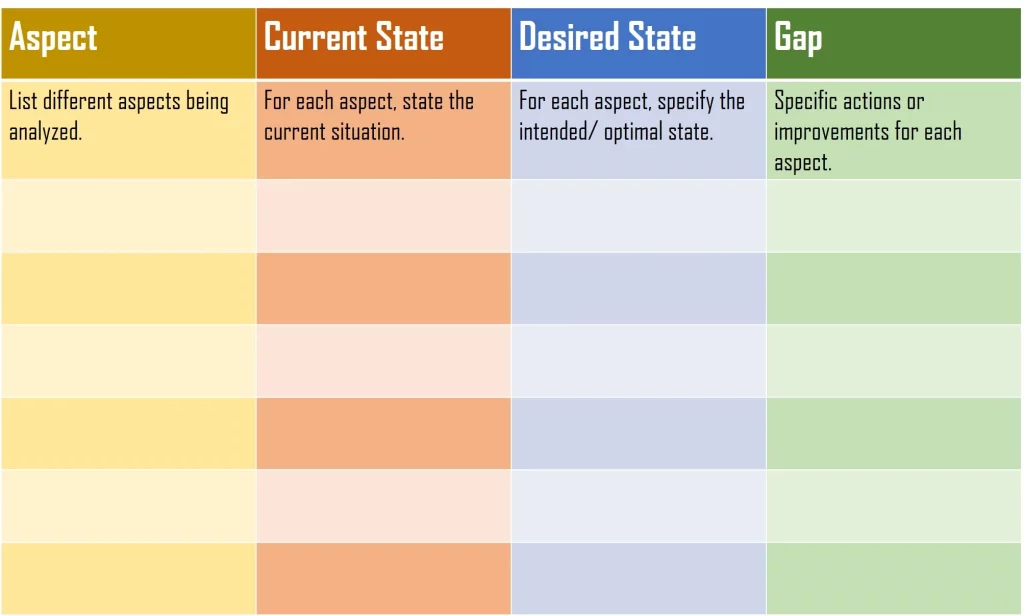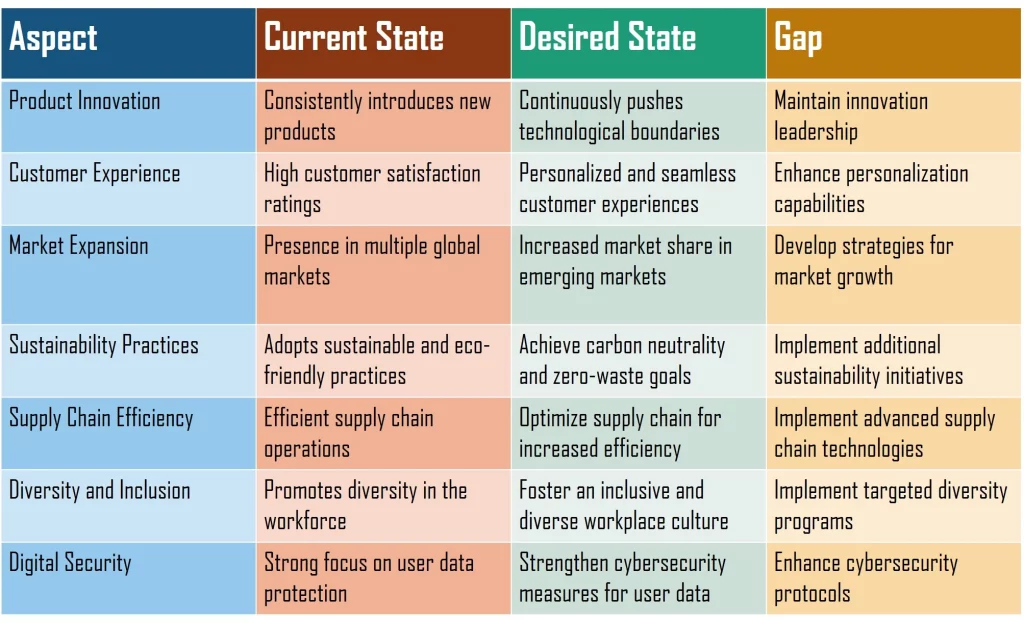
A gap analysis matrix is a visual representation that helps compare the current state of an organization or a project with the desired future state across various dimensions or criteria. The matrix is structured as a table with rows representing different aspects to be analyzed and columns for the current state, desired state, and the gap between them. It allows for a systematic comparison of the existing situation with the intended goals or standards.
Here is a template that students can use to create a gaps analysis matrix:
Key Components
- Aspect: Describes different aspects or criteria being analyzed
- Current State: Describes the current situation or status in each dimension.
- Desired State: Specifies the intended or optimal state for each dimension.
- Gap: Represents the difference between the current state and the desired state. This is where specific actions or improvements are needed.
The gap analysis matrix serves as a tool for visualizing and prioritizing areas that require attention or improvement. It provides a structured way to document and communicate the findings of a gap analysis, making it easier for stakeholders to understand the identified gaps and the corresponding action plans. The matrix can be adapted and customized based on the specific needs and context of the organization.
Example: Phone Manufacturing Company

In this example:
To learn more, review this sample gaps analysis essay.
Tips
- Clearly Define Objectives: Clearly articulate the objectives of your gap analysis. What specific goals are you trying to achieve, and in which areas are you identifying gaps?
- Select Relevant Aspects or Dimensions: Choose the aspects or dimensions that align with your organizational goals. Focus on key areas that impact performance, efficiency, and overall success.
- Be Specific in Describing Current and Desired States: Clearly define the current state and desired state for each aspect. Use specific and measurable terms to describe where you currently stand and where you want to be.
- Use Consistent Metrics: Use consistent metrics or units of measurement across the matrix. This ensures that the comparison between the current and desired states is accurate and meaningful.
- Involve Key Stakeholders: Involve key stakeholders in the creation of the matrix. Their insights can provide a more comprehensive view of the organization’s current state and contribute to the identification of relevant gaps.
- Prioritize Aspects: Prioritize aspects based on their importance and impact on organizational goals. This helps in focusing efforts on addressing the most critical gaps first.
- Consider Quantitative and Qualitative Data: Use a combination of quantitative and qualitative data in your analysis. While quantitative data provides numerical insights, qualitative data adds context and depth to the understanding of gaps.
- Be Realistic in Setting Desired States: Set desired states that are realistic and achievable. Avoid setting goals that are too ambitious or unattainable within the given resources and timeframe.
- Use Visuals for Clarity: Utilize visual elements like color-coding, icons, or graphs to enhance the clarity of the matrix. Visual representations make it easier for stakeholders to quickly grasp the information.
- Include Action Plans: In the “Gap” column, include brief action plans or strategies for addressing each identified gap. This adds a practical dimension to the matrix, outlining the steps needed for improvement.
- Regularly Update the Matrix: Gap analysis is an ongoing process. Regularly update the matrix to reflect changes in the organization’s status, achievements, and new goals. This ensures that the matrix remains a dynamic tool for decision-making.
- Seek Feedback: Gather feedback from relevant stakeholders on the gap analysis matrix. Input from different perspectives can enhance the accuracy and relevance of the analysis.
- Align with Strategic Planning: Ensure that the gap analysis matrix aligns with the organization’s strategic planning. The identified gaps should directly contribute to closing the divide between the current state and strategic objectives.
- Provide Contextual Information: Include contextual information or brief descriptions for each aspect. This helps stakeholders understand the significance of each dimension and its impact on the overall organization.
By following these tips, you can create a comprehensive and actionable gap analysis matrix that serves as a valuable tool for organizational improvement and decision-making.
In conclusion, the key to creating an excellent gap analysis matrix lies in its clarity, specificity, and alignment with organizational objectives. A successful matrix should clearly outline the current state, desired state, and the gaps between them, using measurable and relevant criteria. It should be tailored to the specific context and goals of the organization, ensuring that the identified gaps are strategically prioritized. Regular updates and reviews, along with stakeholder involvement, contribute to the matrix’s effectiveness in guiding decision-making and facilitating continuous improvement.
